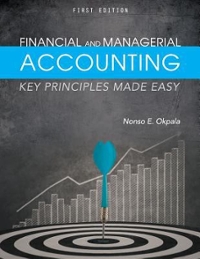Question
Can anyone help me to solve this? all data can use from yahoo finance. please. Step 1: Choose three companies (Make sure to choose firms
Can anyone help me to solve this? all data can use from yahoo finance. please.
Step 1: Choose three companies (Make sure to choose firms with g is small enough):
one firm that pays out dividends whose growth rate is stable (firm A) one firm whose dividends are not paid or fluctuate a lot AND whose EPS and book equity per share are constantly growing at a similar rate. (firm B) one firm whose dividends are not paid or fluctuate a lot AND whose EPS is negative or fluctuates a lot AND whose FCF grows at a stable rate. (firm C) Step 2: Dividend discount model for firm A
Obtain historical dividends per share from income statements in the past 5+ years. Calculate three different growth rates. Choose one and explain why. Obtain the market risk premium, the risk free rate, and beta from any resources. Calculate discount rate using CAPM. Calculate stock price as a PV of all future dividends Search the other intrinsic value calculated by other market experts. Compare with your intrinsic value and explain why they are close or differ.
Step 3: Residual income model for firm B
Obtain book equity per share from B/S and EPS from I/S for the past 5+ years. Calculate historical RIs for the past 5+ years. Calculate three different growth rates of RIs. Choose one and explain why. Obtain the market risk premium, the risk free rate, and beta from any resources. Calculate discount rate using CAPM. Calculate stock price as a PV of all future residual incomes. Search the other intrinsic value calculated by other market experts. Compare with your intrinsic value and explain why they are close or differ.
Step 4: Free cash flow model for firm C
Obtain FCFs for the past 5+ years. If FCF is not available, manually calculate it with the items from BS and IS. Calculate three different growth rates of FCFs. Choose one and explain why. Obtain the market risk premium, the risk-free rate, and beta from any resources. Calculate the asset, or unlevered beta. Calculate FCF's discount rate with firm C's asset beta, market risk premium, and the risk-free rate. Calculate asset value as a PV of all future FCFs. Calculate equity value using the debt to equity ratio or the dollar amount of debt. Divide equity value by the number of shares. Search the other intrinsic value calculated by other market experts. Compare with your intrinsic value and explain why they are close or differ.
VERY OFTEN, you won't get a positive value for your stock price. In those cases:
- check whether your company has a stable growth for dividends, RIs, and FCFs respectively for DDM, RIM, and FCFM.
- choose the minimum growth rate among three possible candidates (geometric, arithmetic, and sustainable)
- use longer-term Treasury yield as the risk-free rate in CAPM so that you can increase the discount rate.
- Expand your dataset. Use 10+ years of historical data to get dividends, RIs, and FCFs.
- If there is a certain year in which div (, RI, or FCF) plunges or shoots up, drop that outlier out of your sample. Of course, you have to check and report what happened in that year in your analysis.
Fundamental Analysis Using Bloomberg Terminal
Step by Step Solution
There are 3 Steps involved in it
Step: 1

Get Instant Access to Expert-Tailored Solutions
See step-by-step solutions with expert insights and AI powered tools for academic success
Step: 2

Step: 3

Ace Your Homework with AI
Get the answers you need in no time with our AI-driven, step-by-step assistance
Get Started


